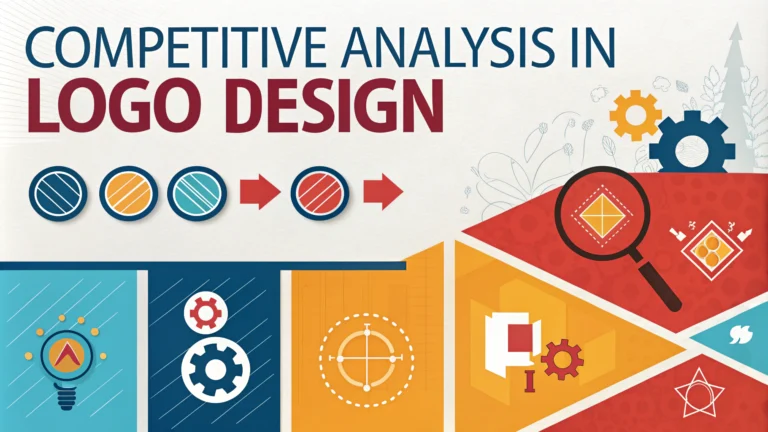A well-executed competitive analysis helps designers create unique logos that stand out in the marketplace while meeting client expectations.
Steps for Logo Design Competitive Analysis
- Research direct competitors in the client’s industry
- Document color schemes and typography choices
- Analyze symbolic elements and visual metaphors
- Study brand positioning and target audience
- Identify market trends and design patterns
Understanding the competitive landscape prevents accidental similarity to existing logos and helps identify opportunities for differentiation.
Tools for Competitive Research
- Behance – Browse professional logo portfolios
- LogoLounge – Search logo design trends
- Pinterest – Create mood boards and collect visual references
- Google Images – Research existing logos in the industry
Elements to Document
| Element | What to Analyze |
|---|---|
| Colors | Primary and secondary color palettes, color psychology |
| Typography | Font styles, custom lettering, spacing |
| Symbols | Common icons, metaphors, abstract vs literal |
| Style | Minimalist, vintage, modern, illustrated |
Red Flags to Watch
- Overused industry symbols (e.g., globes for international businesses)
- Generic color combinations within the industry
- Common typography choices
- Predictable layouts and compositions
Document findings in a structured format, such as a spreadsheet or presentation, to share with clients and team members.
Creating Differentiation
- Explore unconventional color combinations
- Develop unique symbolic representations
- Consider custom typography or hand lettering
- Test multiple design directions
Always validate design choices through user testing and client feedback before finalizing the logo.
Professional Resources
- LogoLounge – Annual logo trends report
- AIGA – Professional association for design
- Brand New – Logo and brand identity reviews
Regular monitoring of competitors’ brand updates helps maintain awareness of market changes and emerging design trends.
Application and Implementation
A thorough competitive analysis forms the foundation for innovative logo design that resonates with target audiences while maintaining uniqueness in the market.
Documentation Best Practices
- Create detailed competitor profile sheets
- Maintain organized digital archives of research
- Use consistent evaluation criteria across all competitors
- Update analysis periodically to track changes
Client Collaboration
- Present findings in clear, visual formats
- Highlight opportunities for differentiation
- Discuss industry constraints and possibilities
- Gather feedback on competitive positioning
Conclusion
Effective competitive analysis in logo design requires systematic research, thorough documentation, and strategic thinking. This process helps designers:
- Create truly distinctive visual identities
- Avoid unintentional similarity to competitors
- Make informed design decisions
- Build stronger client relationships
Regular updates to competitive research ensure continued relevance and effectiveness of logo designs in evolving markets.
Next Steps
- Develop a standardized analysis framework
- Build a reference library of successful case studies
- Establish ongoing market monitoring processes
- Create templates for client presentations
FAQs
- Why is competitive analysis important in logo design?
Competitive analysis helps identify market trends, avoid similarity with competitors’ logos, find unique positioning opportunities, and ensure your design stands out while remaining relevant to the industry. - What elements should I analyze in competitors’ logos?
Analyze color schemes, typography, symbols, shapes, spacing, complexity levels, scalability, and how the logos are applied across different marketing materials and platforms. - How many competitors should I analyze before designing a logo?
Analyze 5-10 direct competitors and 3-5 indirect competitors to get a comprehensive understanding of the market while keeping the research focused and manageable. - How can I ensure my logo design remains unique after competitor analysis?
Document competitor design patterns, deliberately avoid similar elements, focus on your client’s unique value proposition, and create multiple distinct concept variations before finalizing the design. - What tools can I use for logo competitive analysis?
Use tools like Logo Design Matrix, Brand Guidelines Archives, Pinterest Boards, Adobe Color for color analysis, and WhatTheFont for typography identification. - How do I identify direct vs. indirect competitors for logo analysis?
Direct competitors offer similar products/services in the same market, while indirect competitors serve similar customer needs through different products/services or in different markets but may target the same audience. - What are the legal considerations when analyzing competitor logos?
Ensure your design doesn’t infringe on registered trademarks, maintain sufficient visual distinction, and document your research to prove original creation if needed. - How often should competitive logo analysis be updated?
Conduct major competitive analysis every 12-18 months or when planning a rebrand, with minor checks quarterly to stay current with market changes. - What are the common mistakes to avoid in competitive logo analysis?
Avoid copying design elements, focusing only on current trends, analyzing too many competitors, ignoring international markets if relevant, and failing to consider brand context. - How do I present competitive analysis findings to clients?
Create visual mood boards, comparison matrices, written analysis of key findings, market positioning maps, and clear recommendations for differentiation strategies.








